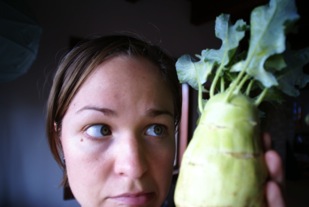
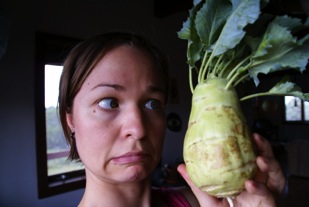
I consider myself a fairly adventurous eater. I’ll try anything once (or two, or three times), and every week at market I make a point to buy any vegetables I’ve never heard of. Still, there are some vegetables I really don’t know what to do with. Thanks to my Southern roots I’ve got a good handle on okra, and eggplant and I are slowly coming to terms (did you see the eggplant curry recipe in our last newsletter?), but this growing season I’ve had to grapple with a new question: what the $&*# do you do with kohlrabi? Before this summer I don’t think I even knew what it was. Thanks to my housemate, I am now plenty familiar: he manages the garden at Salazar Elementary and brings home whatever harvests he can’t find a use for at school. Since no one else knows what to do with them either, the job has fallen to us.
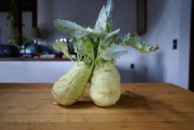
So far I’ve learned that sautéing them takes forever and kohlrabi “fries” just aren’t, which means the last pair of these little buggers has been sitting on our kitchen counter for over a week. Clearly, it’s time to go another direction.
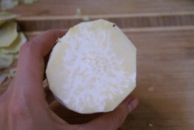 Some notes about kohlrabi before we dive in: kohlrabi is in the same family with broccoli and cabbage. People often compare it to broccoli stems (and in case you didn’t know, you can eat those, too). Look for the smaller heads (3-4 inches in diameter) when making your selection. They’re crisp in texture and taste like a sweet radish, or maybe like really flavorful jicama. That means they can be eaten raw and pair well with other root vegetables. Bigger heads, like ours, have been left on the plant too long. See all that white stuff in there? Those fibers are dry and spongy, so they need special treatment.
Some notes about kohlrabi before we dive in: kohlrabi is in the same family with broccoli and cabbage. People often compare it to broccoli stems (and in case you didn’t know, you can eat those, too). Look for the smaller heads (3-4 inches in diameter) when making your selection. They’re crisp in texture and taste like a sweet radish, or maybe like really flavorful jicama. That means they can be eaten raw and pair well with other root vegetables. Bigger heads, like ours, have been left on the plant too long. See all that white stuff in there? Those fibers are dry and spongy, so they need special treatment.
Every good experiment begins with a question, and mine was: How do you deal with that tough, fibrous texture? This time I decided to use two cooking methods that would push the texture to each extreme. First method: make them really, really crunchy. Second: puree them into oblivion. After doing some research (i.e. googling), I decided on kohlrabi chips and a kohlrabi-potato mash. Here they are:
Method #1: Kohlrabi Chips
You’ll need:
A knife
A glass baking dish
A medium-sized bowl
1-2 heads kohlrabi
1 Tbsp olive oil
salt
pepper
seasonings (pick your favorite– I used onion powder, paprika, and garlic powder)
1. Remove the leaves. You can actually cook the leaves like collard greens, so save them and get more bang for your market buck.

2. Peel the kohlrabi. PEEL THE KOHLRABI. I’m a pretty lazy cook, so I don’t do anything I don’t have to, but… you have to. The skin is just too thick to enhance your dish in any way. There’s a woody part just underneath the skin that also needs to be removed. That potato peeler may look pretty, but I quickly switched to a sharp knife.

3. Slice kohlrabi in half, lengthwise.
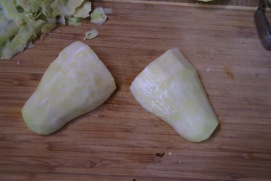
4. Slice into really thin half moons with a good knife or a mandoline. I went with the knife, and they came out mostly even. (If you’ve got young kohlrabi, you can actually stop right here and throw the slices on top of your next salad. I tried a couple of slices and they were sweet, juicy and crunchy… yum!)
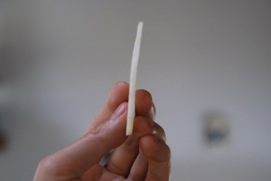
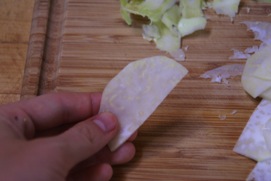
5. Pour 1/2-1 tablespoon olive oil in a bowl with whatever spices you want on your chips. I added a pinch of onion powder, garlic powder, paprika, salt and pepper. Just eyeball it; you can always adjust after you’ve coated the kohlrabi.
Pour in the “chips” and stir to coat. Add more seasoning if you want to.
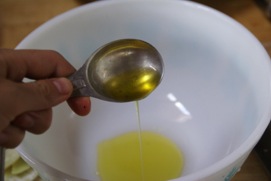
Place slices in a glass dish and put in the oven at 375 degrees F. Bake for 20 minutes or so, turning every 5 minutes to get maximum crispiness.
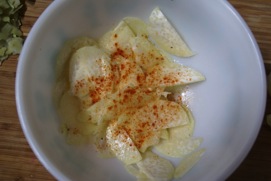
Take them out, let cool, and snap a photo in a sunny spot. Just kidding, but yeah they’re done.
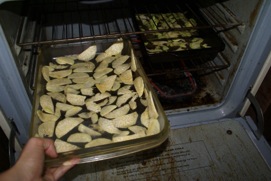
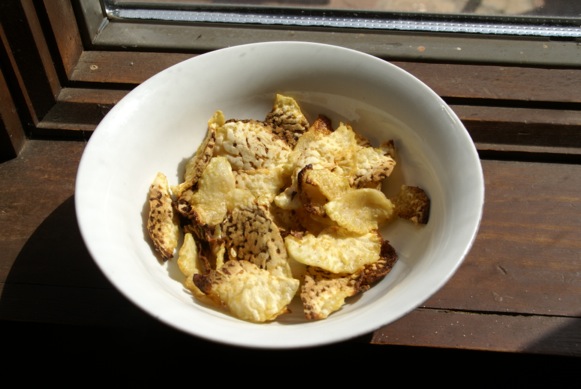
Method #2: Mashed Kohlrabi & Potatoes
You’ll need:
A chopping knife
A steamer basket
A food processor (or bowl and hand masher)
1 head kohlrabi
2-3 small potatoes (pick your favorite mashers)
1-2 Tbsp olive oil
salt
pepper
Your favorite mashed potato seasonings
1. Complete steps 1-3 of Method #1
2. Dice each half into 1/4-in cubes

3. Dice 2-3 small potatoes to the same size, so that you have about a 1:1 ratio of kohlrabi to potato.
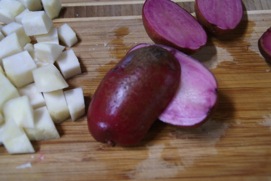
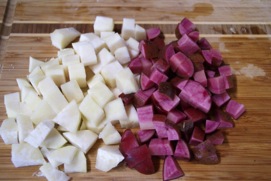
4. Steam the cubes until they are soft. –SERIOUSLY, I think this took 45 minutes. I ended up having to pull out the potatoes so they wouldn’t get too soft while the kohlrabi was still cooking, so I’d say wait 20 minutes before adding them.

5. Stick them in a food processor (or hand mash) with salt, a few swigs of olive oil, and seasonings. (I added a roasted onion and 3 cloves of roasted garlic, but next time I’m blending it with butter and curry spices).
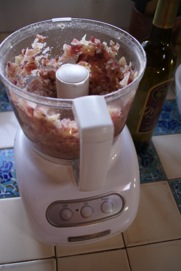
6. EAT IT

The Results
As it turns out, kohlrabi isn’t junk food material (I KNOW, RIGHT? Who knew?). If you’re craving fries or chips, just go for broke and buy potatoes. Oddly enough, the woody fibers turned out to be the best parts, because they really did crisp up well. The rest of the flesh, though, just wouldn’t. The result was half-crispy, half-soggy and not something I’d make again.
Good news on the puree front, though: The mash was delicious, I mean really. I’m putting that one down in the books. The kohlrabi added more flavor than the potatoes would’ve had solo, and the texture was creamy without a trace of those tough little fibers. If I’d added stock and a few more vegetables, it would’ve made a nice creamy soup for this rainy weather.
Steaming the kohlrabi cubes really seemed to do it for softening the vegetable without making it dry or tough, so I’ll probably start there for future experiments. (I’ve read that once they’re steamed, you can throw them in stir fries, pies… even empanadas!) It still took a long time, however, and now that I know I can eat them raw, I’ll probably just make a bunch of jicama-like salads with them.
Have I earned the title of “Kohlrabi Master”? Hardly, but I think we’re making progress.

